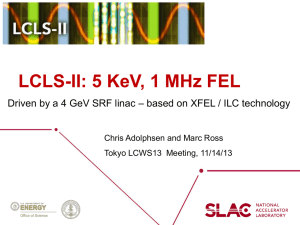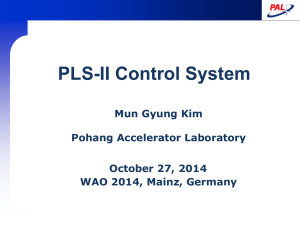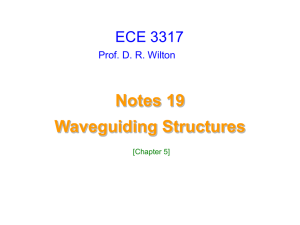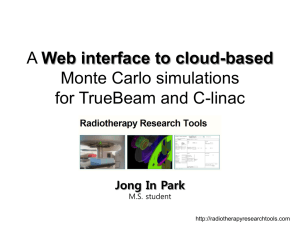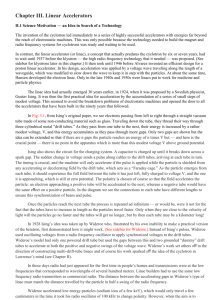phys586-lec27-acc1 - Experimental Elementary Particle Physics
advertisement
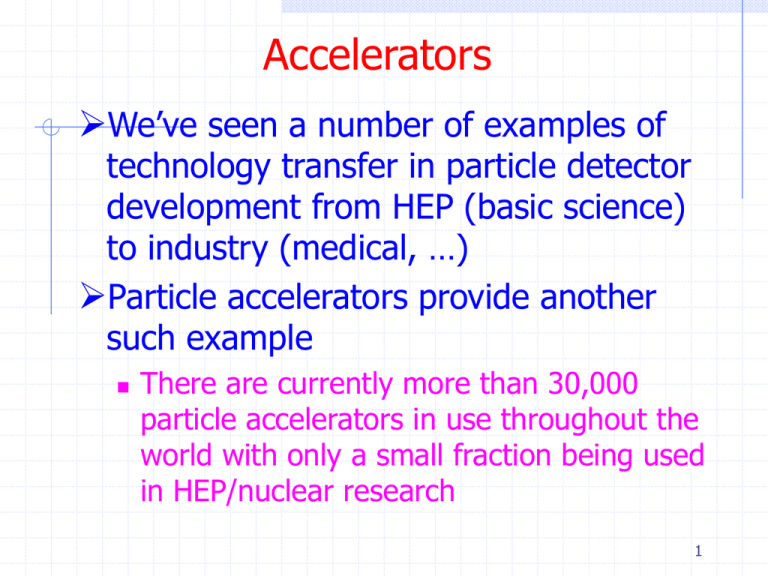
Accelerators We’ve seen a number of examples of technology transfer in particle detector development from HEP (basic science) to industry (medical, …) Particle accelerators provide another such example There are currently more than 30,000 particle accelerators in use throughout the world with only a small fraction being used in HEP/nuclear research 1 Accelerators Circa 2000 2 Accelerators A brief history 3 Accelerators A brief history Electrostatic (Cockcroft-Walton, van de Graaf) Linac (linear accelerator) Circular (cyclotron, betatron, synchrotron) Development of strong focusing Colliding beams (present day) Plasma wakefield, ??? 4 Accelerators “Moore’s law” ~ e+t/C 5 Accelerators “Moore’s law” 6 Linac Linac = linear accelerator Applications in both high energy physics and radiation therapy 7 Linac Linacs are single pass accelerators for electrons, protons, or heavy ions Thus the KE of the beam is limited by length of the accelerator Medical (4-25 MeV) – 0.5-1.5 m SLAC (50 GeV) – 3.2 km ILC (250 GeV) - 11 km Linac – static field, induction (time varying B field), RF Operate in the microwave region Typical RF for medical linacs ~ 2.8 GHz Typical accelerating gradients are 1 MV/m – 100 MV/m 8 Linac Brief history Invented by Wideroe (Germany) in 1928 Accelerated potassium ions to 50 keV using 1 MHz AC First realization of a linac by Sloan (USA) in 1931 No further progress until post-WWII when high power RF generators became available Modern design of enclosing drift tubes in a cavity (resonator) developed by Alvarez (USA) Accelerated 32 MeV protons in 1946 using 200 MHz 12 m long linac Electron linac developed by Hansen and Ginzton (at Stanford) around the same period Evolved into SLAC laboratory and led to the birth of medical linacs (Kaplan and Varian Medical Systems) 9 Linac Wideroe’s linac 10 Linac Alvarez drift tube linac First stage of Fermilab linac 11 Linac A linac uses an oscillating EM field in a resonant cavity or waveguide in order to accelerate particles Why not just use EM field in free space to produce acceleration? We need a metal cavity (boundary conditions) to produce a configuration of waves that is useful Standing wave structures Traveling wave structures 12 LINAC Medical linacs can be either type 13 Waveguides Recall some of Maxwell's equations d SB da 0 and LE dl dt SB da At a boundary between differentmedia BT1 BT2 0 and E||1 E||2 0 In a metalcavity,thefollowingboundary conditionsapply E|| BT 0 at themetalwall We distinguish two sets of solutions TM mode E z 0 TE mode Bz 0 TEM mode cannotoccur 14 Waveguides Cyclindrical wave guide Consider a cylindrical wave guide of radius a Consider the T M modes B z 0 T he z componentof t heE field is given by E z r , E0 J m kc r e i t kz m T hemet allicboundariesare at t hezero's of t heBessel funct ions We also havek 2 k x2 k y2 k z2 k c2 k z2 If k z is real, t he wave propagat es If k z is imaginary,t he wave falls off exponent ia lly T hecut off wavenumber k c is det erminedby t hewaveguide dimensions 15 TM Modes TM01 mode 16 Waveguides T hephase velocityis given by v ph v ph kz k k c No problem thatv c since no information or energyis transmitted But thereis a problemin thatno acceleration is possible d 2 vgr c 1 c / c dk 17 Waveguides Phase and group velocity 18 Waveguides Phase and group velocity E E0 sink dk x w d t E0 sink dk x w d t E 2 E0 sinkx t cosdkx dt E 2 E0 f1 x, t f 2 x, t T hephaseof thefirst termis propagatedso thatkx t is constant T hephase velocityis v p k T hesecond termdefines theenvelopeand again the phaseof this termis propagatedso that xdk td remainsconstant d T hegroup velocityis v g dk Informatio n or energyis propagatedwith thegroup velocity 19 Waveguides The phase velocity can be slowed by fitting the guide with conducting irises or discs The derivation is complicated but alternatively think of the waveguide as a transmission line 1 v ph L0C0 Conducting irises in a waveguide in TM0,1 mode act as discrete capacitors with separation d in parallel with C0 1 v ph L0 C0 C / d 20 Waveguides Disc loaded waveguide 21 Traveling Wave Linac Notes Injection energy of electrons at 50 kV (v=0.4c) The electrons become relativistic in the first portion of the waveguide The first section of the waveguide is described as the buncher section where electrons are accelerated/deaccelerated The final energy is determined by the length of the waveguide In a traveling wave system, the microwaves must enter the waveguide at the electron gun end and must either pass out at the high energy end or be absorbed without reflection 22 Traveling Wave Linac 23 Standing Wave Linac Notes In this case one terminates the waveguide with a conducting disc thus causing a p/2 reflection Standing waves form in the cavities (antinodes and nodes) Particles will gain or receive zero energy in alternating cavities Moreover, since the node cavities don’t contribute to the energy, these cavities can be moved off to the side (side coupling) The RF power can be supplied to any cavity Standing wave linacs are shorter than traveling wave linacs because of the side coupling and also because the electric field is not attenuated 24 Standing Wave Linac 25 Standing Wave Linac Side coupled cavities 26 Electron Source Based on thermionic emission Cathode must be insulated because waveguide is at ground Dose rate can be regulated controlling the cathode temperature Direct or indirect heating The latter does not allow quick changes of electron emission but has a longer lifetime 27 RF Generation Magnetron As seen in your microwave oven! Operation Central cathode that also serves as filament Magnetic field causes electrons to spiral outward As the electrons pass the cavity they induce a resonant, RF field in the cavity through the oscillation of charges around the cavity The RF field can then be extracted with a short antenna attached to one of the spokes 28 RF Generation Magnetron 29 RF Generation Magnetron 30 RF Generation Klystron Used in HEP and > 6 MeV medical linacs Operation – effectively an RF amplifier DC beam produced at high voltage Low power RF excites input cavity Electrons are accelerated or deaccelerated in the input cavity Velocity modulation becomes time modulation during drift Bunched beam excites output cavity Spent beam is stopped 31 RF Generation Klystron 32 Medical Linac Block diagram Electron source Bending magnet Accelerating structure Pulse modulator Klystron or magnetron Treatment head 33 Medical Linac 34 Medical Linac 35 Cyclotron The first circular accelerator was the cyclotron Developed by Lawrence in 1931 (for $25) Grad student Livingston built it for his thesis About 4 inches in diameter 36 Cyclotron Principle of operation Particle acceleration is achieved using an RF field between “dees” with a constant magnetic field to guide the particles 37 Cyclotron Principle of operation qvB m v2 for v c mv p B e e Note t hat thefrequency remainsconstantas the part icleis accelerat ed v v eB eB f 2p 2p m v 2pm Limitedby relat ivitysince v in velocit yand momentum won' t cancelas v approachesc 38 Cyclotron Why don’t the particles hit the pole pieces? The fringe field (gradient) provides vertical and (less obviously) horizontal focusing 39 Cyclotron TRIUMF in Canada has the world’s largest cyclotron 40 Cyclotron TRIUMF 41 Cyclotron NSCL cyclotron at Michigan State 42 Cyclotron 43 Betatron Since electrons quickly become relativistic they could not be accelerated in cyclotrons Kerst and Serber invented the betatron for this purpose (1940) Principle of operation Electrons are accelerated with induced electric fields produced by changing magnetic fields (Faraday’s law) The magnetic field also served to guide the particles and its gradients provided focusing 44 Betatron Principle of operation Steel Coil <B> B0 Vacuum chamber Bguide = 1/2 Baverage 45 Betatron Principle of operation A requirement for theB field of thebetatronis B Borbit 2 d dB Em f A dt dt 2 dB E 2pR pR dt R dB E 2 dt T heforceon theelectronis then dp eR dB F dt 2 dt eRB p eRBorbit 2 46 TM Modes 47 TE Modes Dipole mode Quadrupole mode used in RFQ’s 48 Waveguides , thenk is imaginary Note when a 2 2 c 2 m ,i 2 and the wave no longer propagates Also note 0,1 2.405 2pa 2.61a T husc c 2.405 2pc So thecavityradius determinesthe wavelength For a 10 cm, λ 26 cm and f 1.15 GHz 49
